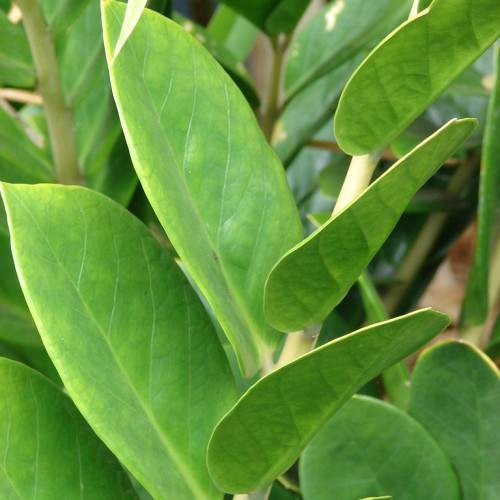
ZZ plant
Zamioculcas zamiifolia
Also Known As - zz plant,feng shui plantCycle:
Herbaceous Perennial
Watering:
Average
Hardiness Zone:
9 - 10
Flowers:
Flowers
Sun:
part shade,part sun/part shade
Fruits:
Fruits In Autumn Ready In
Leaf:
Yes
Growth Rate:
Low
Maintenance:
Low
Drought Tolerant:
Yes
Indoors:
Yes
Care Level:
Low
watering
Watering the ZZ plant is essential for its health and longevity. It is best to give it an occasional deep watering when the top inch or 2 of soil feels dry to the touch. Be careful not to overwater, as this can cause the plant to suffer from root rot. During the growing season, which typically occurs from spring to fall, it should be watered once every 2 to 3 weeks. During the winter months, it can be watered less frequently, only when the soil is dry. It is important to let the soil dry out completely in-between waterings.
sunlight
The ZZ plant (Zamioculcas zamiifolia) requires bright, indirect sunlight for optimal growth. With this species in particular, direct sunlight should be avoided as it can cause leaves to burn or become discolored. The amount of light needed and the duration for optimal growth can differ depending on the situation and location. Generally, it is best to place a ZZ plant in a bright, sunny spot for 6 to 8 hours of good indirect sunlight each day, such as in a south- or east-facing window. In lower-light positions, the amount of light needed can be decreased to 4 to 6 hours each day, or less for less frequently watered plants.
pruning
Pruning ZZ plants is not typically necessary as these plants are slow-growing and produce few lateral leaves. However, if the leaves become too long or the plant is starting to spread out, trimming the leading tips of the stems can help the plant maintain its shape. To do this, use sharp, clean scissors and snip just above a set of leaves. Pruning should be done at any time during the growing season, preferably in the spring or summer. Be aware that frequent pruning can weaken the plant, so use only when needed.
FAQ
Do ZZ plants need to be repotted often??
No, ZZ plants don't need to be repotted often. In fact, they prefer to be rootbound and can even adapt to drought conditions and low light levels. In general, it is best to repot when the plant's roots are significantly filling the current pot, usually every two years. With proper care, your ZZ plant should require repotting only every two to five years.
Could ZZ plants thrive in humid conditions?
The ZZ Plant is an adaptable houseplant that can tolerate different conditions, including humid environments. It grows best in high humidity and warm temperatures, so if the humidity is kept consistent, the ZZ Plant should thrive. Under the right conditions, it can handle temperatures of up to 85°F. Direct sunlight should be avoided for this plant, but if it does come in contact with bright light, avoid allowing the leaves to dry out too much. To reward it with the humidity it loves, mist its foliage several times a week.
